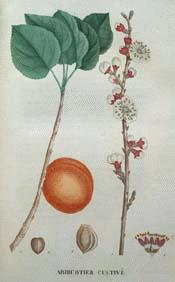
Botanical.com Home Page

|
Apricot
(Armeniaca vulgaris )
Click on graphic for larger image
|
Apricot
Botanical: Prunus Armeniaca (LINN.)
Family: N.O. Rosaceae
---Synonyms---Apricock. Armeniaca vulgaris.
---Parts Used---Kernels, oil.
---Habitat---Although formerly supposed to come from Armenia, where it was long cultivated, hence the name Armeniaca, there is now little doubt that its original habitat is northern China, the Himalaya region and other parts of temperate Asia. It is cultivated generally throughout temperate regions. Introduced into England, from Italy, in Henry VIII's reign.
---Description---A hardy tree, bearing stone fruit, closely related to the peach. The leaves are broad and roundish, with pointed apex; smooth; margin, finely serrated; petiole 1/2 inch to an inch long, generally tinged with red. The flowers are sessile, white, tinged with the same dusky red that appears on the petiole, with five regular sepals and petals and many stamens, and open very early in the spring. The fruit, which ripens end of July to mid-August, according to variety, is a drupe, like the plum, with a thin outer, downy skin enclosing the yellow flesh (mesocarp), the inner layers becoming woody and forming the large, smooth, compressed stone, the ovule ripening into the kernel, or seed. As a rule in Britain, the fruit rarely ripens unless the tree is trained against a wall; when growing naturally, it is a medium-sized tree. It is propagated by budding on the musselplum stock. A great number of varieties are distinguished by cultivators. Large quantities of the fruit are imported from France. The kernels of several varieties are edible and in Egypt, those of the Musch-musch variety form a considerable article of commerce. Like those of the peach, apricot kernels contain constituents similar to those of the bitter almond: they are imported in large quantities from Syria and California and are oftenused by confectioners in the place of bitter almonds, which they so closely resemble as to be with difficulty distinguished.
The French liqueur Eau de Noyaux is prepared from bitter apricot kernels.
---Constituents---Apricot kernels yield by expression 40 to 50 per cent. of a fixed oil, similar to that which occurs in the sweet almond and in the peach kernel, consisting chiefly of Olein, with a small proportion of the Glyceride of Linolic acid, and commonly sold as Peach Kernel oil (Ol. Amygdae Pers.). From the cake is distilled, by digestion with alcohol, an essential oil (0l. Amygdae Essent. Pers.) which contains a colourless, crystalline glucoside, Amygdalin, and is chemically identical with that of the bitter almond. The essential oil is used in confectionery and as a culinary flavouring.
---Medicinal Action and Uses---Apricot oil is used as a substitute for Oil of Almonds, which it very closely resembles. It is far less expensive and finds considerable employment in cosmetics, for its softening action on the skin. It is often fraudulently added to genuine Almond oil and used in the manufacture of soaps, cold creams and other preparations of the perfumery trade.
Common Name Index
A MODERN HERBAL Home Page
Bear in mind "A Modern Herbal" was written with the conventional wisdom of the early 1900's. This should be taken into account as some of the information may now be considered inaccurate, or not in accordance with modern medicine.
© Copyright Protected 1995-2024 Botanical.com
|

